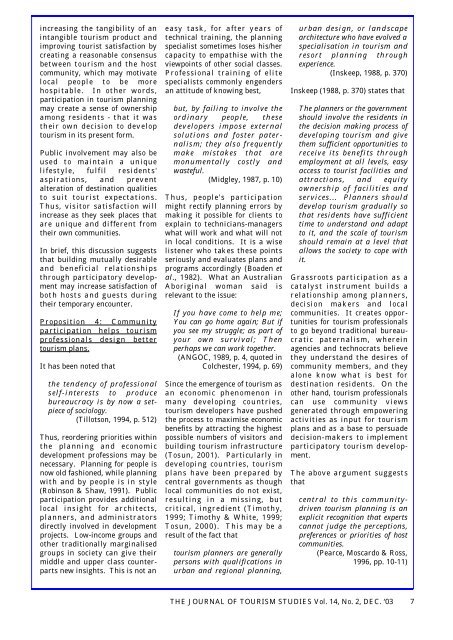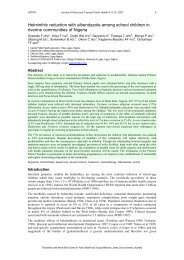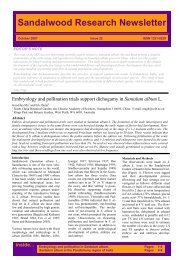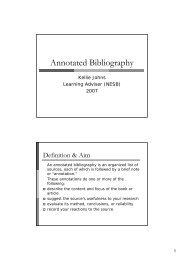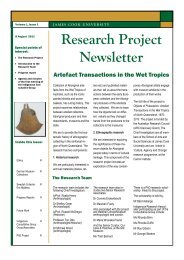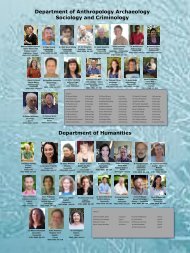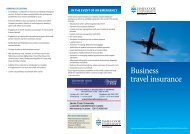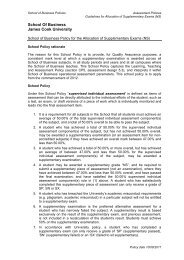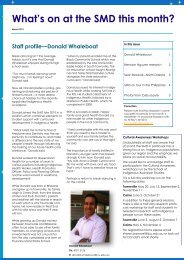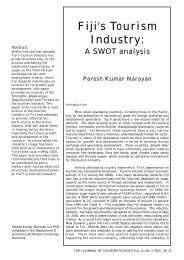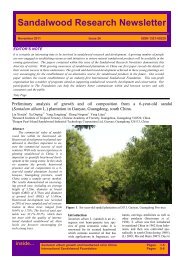Tosun Timothy
Tosun Timothy
Tosun Timothy
You also want an ePaper? Increase the reach of your titles
YUMPU automatically turns print PDFs into web optimized ePapers that Google loves.
increasing the tangibility of an<br />
intangible tourism product and<br />
improving tourist satisfaction by<br />
creating a reasonable consensus<br />
between tourism and the host<br />
community, which may motivate<br />
local people to be more<br />
hospitable. In other words,<br />
participation in tourism planning<br />
may create a sense of ownership<br />
among residents - that it was<br />
their own decision to develop<br />
tourism in its present form.<br />
Public involvement may also be<br />
used to maintain a unique<br />
lifestyle, fulfil residents'<br />
aspirations, and prevent<br />
alteration of destination qualities<br />
to suit tourist expectations.<br />
Thus, visitor satisfaction will<br />
increase as they seek places that<br />
are unique and different from<br />
their own communities.<br />
In brief, this discussion suggests<br />
that building mutually desirable<br />
and beneficial relationships<br />
through participatory development<br />
may increase satisfaction of<br />
both hosts and guests during<br />
their temporary encounter.<br />
Proposition 4: Community<br />
participation helps tourism<br />
professionals design better<br />
tourism plans.<br />
It has been noted that<br />
the tendency of professional<br />
self-interests to produce<br />
bureaucracy is by now a setpiece<br />
of sociology.<br />
(Tillotson, 1994, p. 512)<br />
Thus, reordering priorities within<br />
the planning and economic<br />
development professions may be<br />
necessary. Planning for people is<br />
now old fashioned, while planning<br />
with and by people is in style<br />
(Robinson & Shaw, 1991). Public<br />
participation provides additional<br />
local insight for architects,<br />
planners, and administrators<br />
directly involved in development<br />
projects. Low-income groups and<br />
other traditionally marginalised<br />
groups in society can give their<br />
middle and upper class counterparts<br />
new insights. This is not an<br />
easy task, for after years of<br />
technical training, the planning<br />
specialist sometimes loses his/her<br />
capacity to empathise with the<br />
viewpoints of other social classes.<br />
Professional training of elite<br />
specialists commonly engenders<br />
an attitude of knowing best,<br />
but, by failing to involve the<br />
ordinary people, these<br />
developers impose external<br />
solutions and foster paternalism;<br />
they also frequently<br />
make mistakes that are<br />
monumentally costly and<br />
wasteful.<br />
(Midgley, 1987, p. 10)<br />
Thus, people's participation<br />
might rectify planning errors by<br />
making it possible for clients to<br />
explain to technicians-managers<br />
what will work and what will not<br />
in local conditions. It is a wise<br />
listener who takes these points<br />
seriously and evaluates plans and<br />
programs accordingly (Boaden e t<br />
a l., 1982). What an Australian<br />
Aboriginal woman said is<br />
relevant to the issue:<br />
If you have come to help me;<br />
You can go home again; But if<br />
you see my struggle; as part of<br />
your own survival; Then<br />
perhaps we can work together.<br />
(ANGOC, 1989, p. 4, quoted in<br />
Colchester, 1994, p. 69)<br />
Since the emergence of tourism as<br />
an economic phenomenon in<br />
many developing countries,<br />
tourism developers have pushed<br />
the process to maximise economic<br />
benefits by attracting the highest<br />
possible numbers of visitors and<br />
building tourism infrastructure<br />
(<strong>Tosun</strong>, 2001). Particularly in<br />
developing countries, tourism<br />
plans have been prepared by<br />
central governments as though<br />
local communities do not exist,<br />
resulting in a missing, but<br />
critical, ingredient (<strong>Timothy</strong>,<br />
1999; <strong>Timothy</strong> & White, 1999;<br />
<strong>Tosun</strong>, 2000). This may be a<br />
result of the fact that<br />
tourism planners are generally<br />
persons with qualifications in<br />
urban and regional planning,<br />
urban design, or landscape<br />
architecture who have evolved a<br />
specialisation in tourism and<br />
resort planning through<br />
experience.<br />
(Inskeep, 1988, p. 370)<br />
Inskeep (1988, p. 370) states that<br />
The planners or the government<br />
should involve the residents in<br />
the decision making process of<br />
developing tourism and give<br />
them sufficient opportunities to<br />
receive its benefits through<br />
employment at all levels, easy<br />
access to tourist facilities and<br />
attractions, and equity<br />
ownership of facilities and<br />
services... Planners should<br />
develop tourism gradually so<br />
that residents have sufficient<br />
time to understand and adapt<br />
to it, and the scale of tourism<br />
should remain at a level that<br />
allows the society to cope with<br />
it.<br />
Grassroots participation as a<br />
catalyst instrument builds a<br />
relationship among planners,<br />
decision makers and local<br />
communities. It creates opportunities<br />
for tourism professionals<br />
to go beyond traditional bureaucratic<br />
paternalism, wherein<br />
agencies and technocrats believe<br />
they understand the desires of<br />
community members, and they<br />
alone know what is best for<br />
destination residents. On the<br />
other hand, tourism professionals<br />
can use community views<br />
generated through empowering<br />
activities as input for tourism<br />
plans and as a base to persuade<br />
decision-makers to implement<br />
participatory tourism development.<br />
The above argument suggests<br />
that<br />
central to this communitydriven<br />
tourism planning is an<br />
explicit recognition that experts<br />
cannot judge the perceptions,<br />
preferences or priorities of host<br />
communities.<br />
(Pearce, Moscardo & Ross,<br />
1996, pp. 10-11)<br />
THE JOURNAL OF TOURISM STUDIES Vol. 14, No. 2, DEC. ‘03 7


